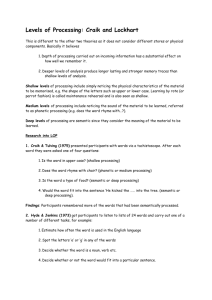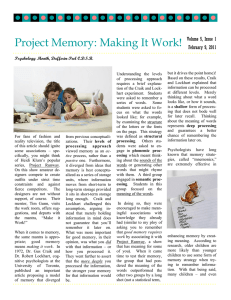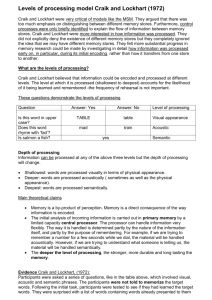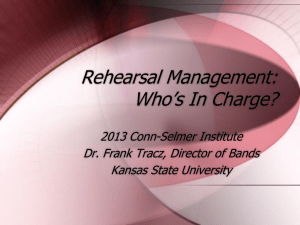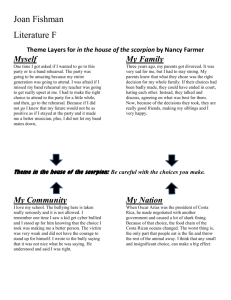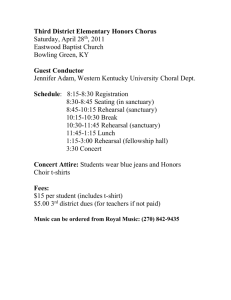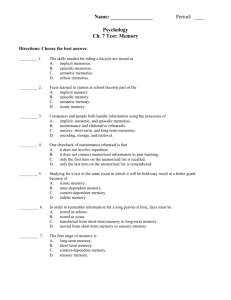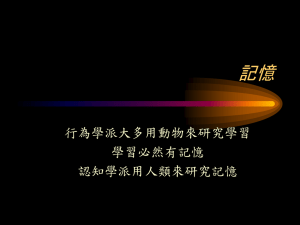010 Information Processing Theory 05
advertisement
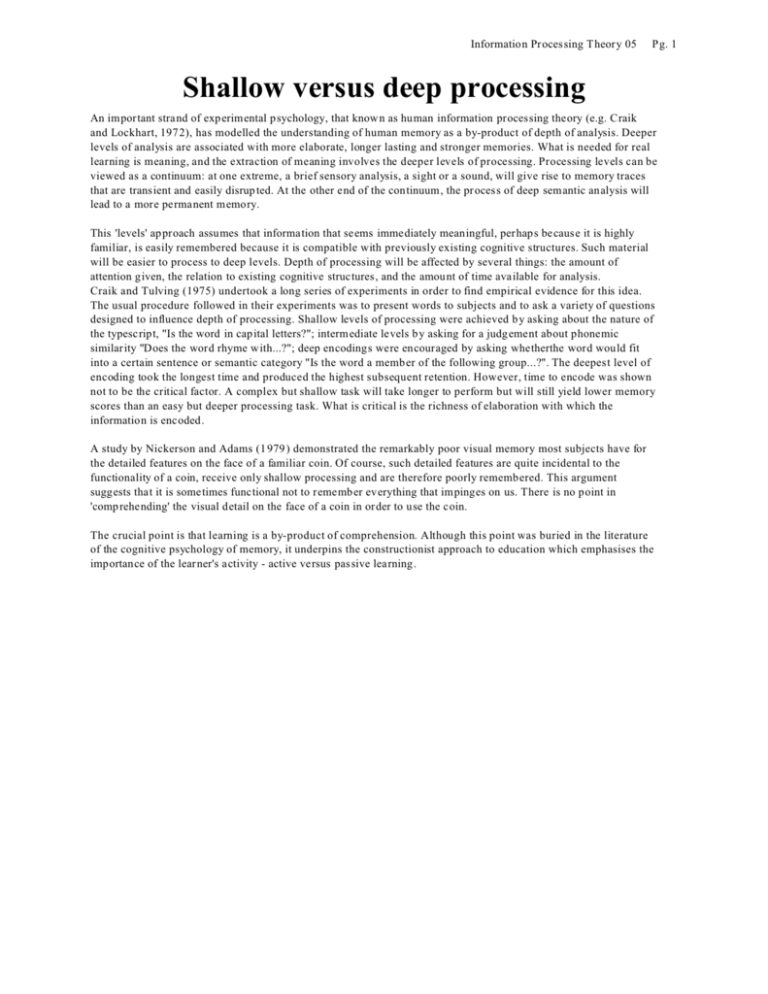
Information Processing Theory 05 Pg. 1 Shallow versus deep processing An important strand of experimental psychology, that know n as human information processing theory (e.g. Craik and Lockhart, 1972), has modelled the understanding of human memory as a by-product of depth of analysis. Deeper levels of analysis are associated with more elaborate, longer lasting and stronger memories. What is needed for real learning is meaning, and the extraction of meaning involves the deeper levels of processing. Processing levels can be viewed as a continuum: at one extreme, a brief sensory analysis, a sight or a sound, will give rise to memory traces that are transient and easily disrup ted. At the other end of the continuum, the process of deep semantic analysis will lead to a more permanent memory. This 'levels' approach assumes that information that seems immediately meaningful, perhaps because it is highly familiar, is easily remembered because it is compatible with previously existing cognitive structures. Such material will be easier to process to deep levels. Depth of processing will be affected by several things: the amount of attention given, the relation to existing cognitive structures, and the amount of time available for analysis. Craik and Tulving (1975) undertook a long series of experiments in order to find empirical evidence for this idea. The usual procedure followed in their experiments was to present words to subjects and to ask a variety of questions designed to influence depth of processing. Shallow levels of processing were achieved by asking about the nature of the typescript, "Is the word in capital letters?"; intermediate levels by asking for a judgement about phonemic similarity "Does the word rhyme with...?"; deep encodings were encouraged by asking whetherthe word would fit into a certain sentence or semantic category "Is the word a member of the following group...?". The deepest level of encoding took the longest time and produced the highest subsequent retention. However, time to encode was shown not to be the critical factor. A complex but shallow task will take longer to perform but will still yield lower memory scores than an easy but deeper processing task. What is critical is the richness of elaboration with which the information is encoded. A study by Nickerson and Adams (1 979 ) demonstrated the remarkably poor visual memory most subjects have for the detailed features on the face of a familiar coin. Of course, such detailed features are quite incidental to the functionality of a coin, receive only shallow processing and are therefore poorly remembered. This argument suggests that it is sometimes functional not to remember everything that impinges on us. There is no point in 'comp rehending' the visual detail on the face of a coin in order to use the coin. The crucial point is that learning is a by-product of comprehension. Although this point was buried in the literature of the cognitive psychology of memory, it underpins the constructionist approach to education which emphasises the importance of the learner's activity - active versus passive learning. Information Processing Theory 05 Pg. 2 The Levels-of-Processing Approach The levels of processing approach also known as the depth of processing approach, which was studied by Craik and Lockhart(1972 ),proposes that how will information is remembered dep ends on how it is processed. The two types of processing are those of shallow processing and deep processing. Shallow processing of information involves the information being processed in thw ways that it actually looks or how the human senses actually record it. With shallow processing, the information will not be rememb ered as well as it would with deep processing. In deep processing, information is processed in terms of its meaning, this meaning may be analysed in terms of other association, images ,or past exp eriences which are related to the information being processed. With either shallow or deep processing, a memory trace is created. In shallow processing, the memory trace will be fragile and information will be quickly forgotten. With deep processing, the memory trace will be durable and information will be rememb ered. In Craik and Lockhart's (197 2) model, they prop osed two types of rehearsal, like that in the Atkinson-Shiffrin Model. These types are maintenance rehearsal, in which information is simply repeated as already mentioned in the Atkinson-S hiffrin Model. W hereas, elab orative rehearsal refers to trying to rehearse the information in relation to its meaning, and trying to associate images and past exp eriences in the rehearsal. Tulving's Model Endel Tulving(1972 ) proposed a model of memory in which he distinguished between the Short Term Memory and the other memories. The nmain memories which he focused on were Episodic and Semantic Memory. In 1987 , Tulving expanded his model adding Procedural Memory. Episodic Memory is where information is stored about events that have happened, and are going to happen, and the relationships between these events, basically it refers to personal experiences. Semantic Memory is made up of all the information one knows about the outside world. Information in this memory is very consistent compared to that of information in episodic memory which is forever changing. It includes knowledge about words and also information that may not be able to be explained through words. Tulving's most recent memory, Procedural Memory contains information on how to do som ething or learning connections between stimuli and responses(M atlin,19 98 ). The Atkinson-Shiffrin Model The very first place in which external stimuli goes to in relation to memory, is the Sensory Memory. Sensory Memory stores all the information from all of the human senses, it does this very accurately, although the information in this memory lasts for a very short time. Atkinson and Shiffrin propose that the information in the Sensory Memory then flows into the Short Term Memory(STM ). The Short Term Memory can only hold a relatively small amount of information in it, is said to hold around seven give or take a few pieces of information or objects in it. The information in this memory lasts for a small amount of time as well, around 30 seconds which is a lot longer than the Sensory Memory. Within this 30 seconds, if the information is not somehow repeated and remembered, it will be lost from the Short Term M emory. If the information is sucessfully remembered and not lost, it will flow onto the Long Term M emory(LTM). This is the largest memory store in this model of memory. The Long Term Memory has a unlimited capacity to which it can be filled with information and this information does not last for any specific duration of time. In fact it has a unlimited lifetime in this memory. Memories that have entered the Long Term Memory recently mix with memories which are decades old. Some memories here though can be lost through illness and a loss of strength in the Long Term Memory. One imp ortant Control Process(strategy) for memory is that of Rehearsal, the repetition of information. This control process will make sure that information in the Short Term Memory can be remembered, and flow onto the Long Term Memory. Information Processing Theory 05 Pg. 3 Incidental Learning Paradigm The incidental learning paradigm is an experimental paradigm used to investigate learning without intent. U sing this paradigm, several group s of subjects are presented with the sam e list of items (e.g., 20 words) and are instructed to process them in different ways (different orienting conditions), with each group asked to p erform a different activity or orienting task with the list. For examp le, · count the number of letters in each word (shallow processing) · name a rhyming word for each item (again, shallow processing, but deeper than #1 · form an image of each word and rate the vividness of each image (deep processing). Importantly, subjects are not told that there will be a subsequent test of memory. At the end of the list presentation, subjects are unexpectedly asked to recall as many of the words as possible. Processing information at a deeper level results in sup erior recall of that information (Eysenck, 19 74). Elaborative Rehearsal Elaborative rehearsal is a type of rehearsal proposed b y Craik and Lockhart (1972 ) in their Levels of Processing model of memory. In contrast to maintenance rehearsal, which involves simple rote repetition, elaborative rehearsal involves deep sematic p rocessing of a to-be-remembered item resulting in the production of durable memories. For example, if you were presented with a list of digits for later recall (4968214), group ing the digits together to form a phone numb er transforms the stimuli from a meaningless string of digits to something that has meaning. Information Processing Theory 05 References Craik, F.I.M., & Lockhart, R.S. (1972). Levels of processing. A framework for memory research. Journal of Verbal Learning and V erbal Behaviour, 11 , 671-68 4. Maintenance Rehearsal Maintenance rehearsal is a type of rehearsal proposed b y Craik and Lockhart (1972 ) in their Levels of Processing Model of memory. Maintenance rehearsal involves rote repetition of an item's auditory representation. In contrast to elaborative rehearsal, this type of rehearsal does not lead to stronger or more durable mem ories. References Craik, F.I.M., & Lockhart, R.S. (1972). Levels of processing. A framework for memory research. Journal of Verbal Learning and V erbal Behaviour, 11 , 671-68 4. Pg. 4
